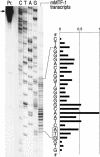Characterization of the mouse gene for the heavy metal-responsive transcription factor MTF-1
- PMID: 11005378
- PMCID: PMC312886
- DOI: 10.1379/1466-1268(2000)005<0196:cotmgf>2.0.co;2
Characterization of the mouse gene for the heavy metal-responsive transcription factor MTF-1
Abstract
MTF-1 is a zinc finger transcription factor that mediates the cellular response to heavy metal stress; its targeted disruption in the mouse leads to liver decay and embryonic lethality at day E14. Recently, we have sequenced the entire MTF-1 gene in the compact genome of the pufferfish Fugu rubripes. Here we have defined the promoter sequences of human and mouse MTF-1 and the genomic structure of the mouse MTF-1 locus. The transcription unit of MTF-1 spans 42 kb (compared to 8.5 kb in Fugu) and is located downstream of the gene for a phosphatase (INPP5P) in mouse, human, and fish. In all of these species, the MTF promoter region has the features of a CpG island. In both mouse and human, the 5' untranslated region harbors conserved short reading frames of unknown function. RNA mapping experiments revealed that in these two species, MTF-1 mRNA is transcribed from a cluster of multiple initiation sites from a TATA-less promoter without metal-responsive elements. Transcription from endogenous and transfected MTF-1 promoters was not affected by heavy metal load or other stressors, in support of the notion that MTF-1 activity is regulated at the posttranscriptional level. Tissue Northern blots normalized for poly A+ RNA indicate that MTF-1 is expressed at similar levels in all tissues, except in the testes, that contain more than 10-fold higher mRNA levels.
Figures





Similar articles
-
The Drosophila homolog of mammalian zinc finger factor MTF-1 activates transcription in response to heavy metals.Mol Cell Biol. 2001 Jul;21(14):4505-14. doi: 10.1128/MCB.21.14.4505-4514.2001. Mol Cell Biol. 2001. PMID: 11416130 Free PMC article.
-
Characterization of the transcription factor MTF-1 from the Japanese pufferfish (Fugu rubripes) reveals evolutionary conservation of heavy metal stress response.Biol Chem. 1999 Feb;380(2):175-85. doi: 10.1515/BC.1999.026. Biol Chem. 1999. PMID: 10195425
-
Functional domains of the heavy metal-responsive transcription regulator MTF-1.Nucleic Acids Res. 1995 Jun 25;23(12):2277-86. doi: 10.1093/nar/23.12.2277. Nucleic Acids Res. 1995. PMID: 7610056 Free PMC article.
-
[Transcription Factor MTF-1 Involved in the Cellular Response to Zinc].Yakugaku Zasshi. 2021;141(6):857-867. doi: 10.1248/yakushi.20-00247. Yakugaku Zasshi. 2021. PMID: 34078794 Review. Japanese.
-
Cellular zinc sensors: MTF-1 regulation of gene expression.Biometals. 2001 Sep-Dec;14(3-4):223-37. doi: 10.1023/a:1012932712483. Biometals. 2001. PMID: 11831458 Review.
Cited by
-
The EVER proteins as a natural barrier against papillomaviruses: a new insight into the pathogenesis of human papillomavirus infections.Microbiol Mol Biol Rev. 2009 Jun;73(2):348-70. doi: 10.1128/MMBR.00033-08. Microbiol Mol Biol Rev. 2009. PMID: 19487731 Free PMC article. Review.
-
The metal-responsive transcription factor-1 protein is elevated in human tumors.Cancer Biol Ther. 2010 Mar 15;9(6):469-76. doi: 10.4161/cbt.9.6.10979. Epub 2010 Mar 20. Cancer Biol Ther. 2010. PMID: 20087061 Free PMC article.
-
Genome-wide screening in pluripotent cells identifies Mtf1 as a suppressor of mutant huntingtin toxicity.Nat Commun. 2023 Jul 5;14(1):3962. doi: 10.1038/s41467-023-39552-9. Nat Commun. 2023. PMID: 37407555 Free PMC article.
-
Target gene search for the metal-responsive transcription factor MTF-1.Nucleic Acids Res. 2001 Apr 1;29(7):1514-23. doi: 10.1093/nar/29.7.1514. Nucleic Acids Res. 2001. PMID: 11266553 Free PMC article.
-
The Drosophila homolog of mammalian zinc finger factor MTF-1 activates transcription in response to heavy metals.Mol Cell Biol. 2001 Jul;21(14):4505-14. doi: 10.1128/MCB.21.14.4505-4514.2001. Mol Cell Biol. 2001. PMID: 11416130 Free PMC article.
References
-
- Auf der Maur A, Belser T, Elgar G, Georgiev O, Schaffner W. Characterization of the transcription factor MTF-1 from the Japanese pufferfish (Fugu rubripes) reveals evolutionary conservation of heavy metal stress response. Biol Chem. 1999;380:175–185. - PubMed
-
- Beg AA, Sha WC, Bronson RT, Ghosh S, Baltimore D. Embryonic lethality and liver degeneration in mice lacking the RelA component of NK-kappa B. Nature. 1995;376:167–170. - PubMed
-
- Bittel D, Dalton T, Samson SL, Gedamu L, Andrews GK. The DNA binding activity of metal response element-binding transcription factor-1 is activated in vivo and in vitro by zinc, but not by other transition metals. J Biol Chem. 1998;273:7127–7133. - PubMed
-
- Brown CY, Mize GJ, Pineda M, George DL, Morris DR. Role of two upstream open reading frames in the translational control of oncogene mdm2. Oncogene. 1999;18:5631–5637. - PubMed
-
- Cross SH, Bird AP. CpG islands and genes. Curr Opin Genet Dev. 1995;5:309–314. - PubMed
Publication types
MeSH terms
Substances
LinkOut - more resources
Full Text Sources
Molecular Biology Databases
Miscellaneous
